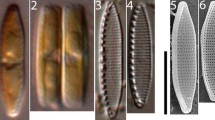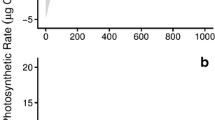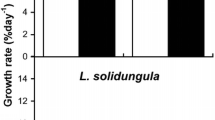Abstract
Mechanisms of inorganic carbon assimilation were investigated in the four deep-water kelps inhabiting sea bottoms at the Strait of Gibraltar; these species are distributed at different depths (Saccorhiza polysiches at shallower waters, followed by Laminaria ochroleuca, then Phyllariopsis brevipes and, at the deepest bottoms, Phyllariopsis purpurascens). To elucidate the capacity to use HCO3 − as a source of inorganic carbon for photosynthesis in the kelps, different experimental approaches were used. Specifically, we measured the irradiance-saturated gross photosynthetic rate versus pH at a constant dissolved inorganic carbon (DIC) concentration of 2 mM, the irradiance-saturated apparent photosynthesis (APS) rate versus DIC, the total and the extracellular carbonic anhydrase (CAext), the observed and the theoretical photosynthetic rates supported by the spontaneous dehydration of HCO3 − to CO2, and the δ13C signature in tissues of the algae. While S. polyschides and L. ochroleuca showed photosynthetic activity at pH 9.5 (around 1.0 µmol O2 m−2 s−1), the activity was close to zero in both species of Phyllariopsis. The APS versus DIC was almost saturated for the DIC values of natural seawater (2 mM) in S. polyschides and L. ochroleuca, but the relationship was linear in P. brevipes and P. purpurascens. The four species showed total and CAext activities but the inhibition of the CAext originated the observed photosynthetic rates at pH 8.0 to be similar to the theoretical rates that could be supported by the spontaneous dehydration of HCO3 −. The isotopic 13C signatures ranged from −17.40 ± 1.81 to −21.11 ± 1.73 ‰ in the four species. Additionally, the δ13C signature was also measured in the deep-water Laminaria rodriguezii growing at 60–80 m, showing even a more negative value of −26.49 ± 1.25 ‰. All these results suggest that the four kelps can use HCO3 − as external carbon source for photosynthesis mainly by the action of external CAext, but they also suggest that the species inhabiting shallower waters show a higher capacity than the smaller kelps living in deeper waters. In fact, the photosynthesis in the two Phyllariopsis species could be accomplished by the spontaneous dehydration of HCO3 − to CO2. These differences in the capacity to use HCO3 − in photosynthesis among species could be important considering the increasing levels of atmospheric CO2 predicted for the near future.


Similar content being viewed by others
Abbreviations
- APS:
-
Apparent photosynthesis rate
- APSmax :
-
Irradiance-saturated apparent photosynthesis rate
- AZ:
-
Acetazolamide
- CA:
-
Carbonic anhydrase
- CAext :
-
Extracellular carbonic anhydrase
- C c :
-
Inorganic carbon compensation point
- CCM:
-
CO2 concentration mechanism
- C i :
-
Inorganic carbon
- DIC:
-
Dissolved inorganic carbon
- g P(DIC):
-
Photosynthetic conductance for DIC
- GPSmax :
-
Irradiance-saturated gross photosynthesis rate
- K 0.5 :
-
Half-saturation constant
- pHc :
-
pH compensation point
References
Axelsson L (1988) Changes in pH as a measure of photosynthesis by marine macroalgae. Mar Biol 97:287–294. doi:10.1007/BF00391314
Axelsson L, Uusitalo J (1988) Carbon acquisition strategies for marine macroalgae. I. Utilization of proton exchanges visualized during photosynthesis in a closed system. Mar Biol 97:295–300. doi:10.1007/BF00391315
Axelsson L, Larsson C, Ryberg H (1999) Affinity, capacity and oxygen sensitivity of two different mechanisms for bicarbonate utilization in Ulva lactuca L. (Chlorophyta). Plant, Cell Environ 22:969–978. doi:10.1046/j.1365-3040.1999.00470.x
Axelsson L, Mercado JM, Figueroa FL (2000) Utilization of HCO3 − at high pH by the brown macroalga Laminaria saccharina. Eur J Phycol 35:53–59. doi:10.1080/09670260010001735621
Björk M, Haglund K, Ramazanov Z, García-Reina G, Pedersén M (1992) Inorganic-carbon assimilation in the green seaweed Ulva rigida C. Ag. (Chlorophyceae). Planta 187:152–156. doi:10.1007/BF00201637
Connell SD, Russell BD (2010) The direct effects of increasing CO2 and temperature on non-calcifying organisms: increasing the potential for phase shifts in kelp forests. Proc Biol Sci 277:1409–1415. doi:10.1098/rspb.2009.2069
Cornwall C, Hepburn CD, Pritchard D, McGraw C, Hunter K, Hurd CL (2012) Carbon-use strategies in macroalgae: differential responses to lowered pH and implications for ocean acidification. J Phycol 48:137–144. doi:10.1111/j.1529-8817.2011.01085.x
Drechsler Z, Sharkia R, Cabantchik ZI, Beer S (1993) Bicarbonate uptake in the marine macroalga Ulva sp. is inhibited by classical probes of anion exchange by red blood cells. Planta 191:34–40
Edwards G, Walker DA (1983) C3, C4. Molecular, cellular and environmental regulation of photosynthesis. Blackwell Science, Oxford
Fernández P, Hurd CL, Roleda M (2014) Bicarbonate uptake via an anion exchange protein is the main mechanism of inorganic carbon acquisition by the giant kelp Macrocystis pyrifera (Laminariales, Phaeophyceae) under variable pH. J Phycol 50:998–1008. doi:10.1111/jpy.12247
Fernández P, Roleda M, Hurd CL (2015) Effects of ocean acidification on the photosynthetic performance, carbonic anhydrase activity and growth of the giant kelp Macrocystis pyrifera. Photosynth Res 124:293–304. doi:10.1007/s11120-015-0138-5
Flores-Moya A (1997) Changes in reproductive effort, lamina area index and standing crop with depth in the deep water brown alga Phyllariopsis purpurascens (Laminariales). Phycologia 36:32–37. doi:10.2216/i0031-8884-36-1-32.1
Flores-Moya A (2012) Warm temperate communities: a case study of deep water kelp forests from the Alborán Sea (SW Mediterranean Sea) and the Strait of Gibraltar. In: Wiencke C, Bischof K (eds) Seaweed biology. Ecological studies 219. Springer, Berlin, pp 315–328
Flores-Moya A, Fernández JA (1998) The role of external carbonic anhydrase in the photosynthetic use of inorganic carbon in the deep-water alga Phyllariopsis purpurascens (Laminariales, Phaeophyta). Planta 207:115–119. doi:10.1007/s004250050462
Flores Moya A, Fernández JA, Niell FX (1995) Seasonal variations of photosynthetic pigments, total C, N, and P content, and photosynthesis in Phyllariopsis purpurascens (Phaeophyta) from the Strait of Gibraltar. J Phycol 31:867–874. doi:10.1111/j.0022-3646.1995.00867.x
Gaitián-Espitia JD, Hancock JR, Padilla-Gamiño JL, Rivest EB, Blanchette CA, Reed DC, Hofmann GE (2014) Interactive effects of elevated temperature and pCO2 on early–life–history stages of the giant kelp Macrocystis pyrifera. J Exp Mar Biol Ecol 457:51–58. doi:10.1016/j.jembe.2014.03.018
Giordano M, Beardall J, Raven JA (2005) CO2 concentrating mechanisms in algae. Mechanisms, environmental modulation, and evolution. Annu Rev Plant Biol 56:99–131. doi:10.1146/annurev.arplant.56.032604.144052
Haglund K, Björk M, Ramazanov Z, García-Reina G, Pedersén M (1992a) Role of carbonic anhydrase in photosynthesis and inorganic-carbon assimilation in the red alga Gracilaria tenuistipitata. Planta 187:275–281. doi:10.1007/BF00201951
Haglund K, Ramazanov Z, Mtolera M, Pedersén M (1992b) Role of external carbonic anhydrase in light-dependent alkalization by Fucus serratus L. and Laminaria saccharina (L.) Lamour. (Phaeophyta). Planta 188:1–6. doi:10.1007/BF01160705
Hammer Ø, Harpe DAT, Ryan PD (2001) PAST: paleontological statistics software package for education and data analysis. Palaeontol Electron 4:1–9. http://palaeo-electronica.org/2001_1/past/issue1_01.htm
Hellblom F, Beer S, Björk M, Axelsson L (2001) A buffer sensitive inorganic carbon utilization system in Zostera marina. Aquat Bot 69:55–62. doi:10.1016/S0304-3770(00)00132-7
Hepburn DC, Pritchard DW, Cornwall CE, McLeod RJ, Beardall J, Raven JA, Hurd CL (2011) Diversity of carbon use strategies in a kelp forest community: implications for a high CO2 ocean. Glob Change Biol 17:2488–2497. doi:10.1111/j.1365-2486.2011.02411.x
Hurd CL (2000) Water motion, marine macroalgal ecophysiology and production. J Phycol 36:453–472. doi:10.1046/j.1529-8817.2000.99139.x
Johnson KS (1982) Carbon dioxide hydration and dehydration kinetics in seawater. Limnol Oceanogr 27:849–855
Johnston AM (1991) The acquisition of inorganic carbon by marine macroalgae. Can J Bot 69:1123–1132. doi:10.1139/b91-144
Klenell M, Snoeijs P, Pedersén M (2002) The involvement of a membrane H+-ATPase in the blue-light enhancement of photosynthesis in Laminaria digitata (Phaeophyta). J Phycol 38:1143–1149. doi:10.1046/j.1529-8817.2002.02063.x
Klenell M, Snoeijs P, Pedersén M (2004) Active carbon uptake in Laminaria digitata and L. saccharina (Phaeophyta) is driven by a proton pump in the plasma membrane. Hydrobiologia 514:41–53. doi:10.1007/978-94-017-0920-0_4
Kübler JE, Raven JA (1994) Consequences of light limitation for inorganic carbon acquisition in three rhodophytes. Mar Ecol Prog Ser 110:203–209
Maberly SC (1990) Exogenous sources of inorganic carbon for photosynthesis by marine macroalgae. J Phycol 26:439–449. doi:10.1111/j.0022-3646.1990.00439.x
Maberly SC, Raven JA, Johnston AM (1992) Discrimination between 12C and 13C by marine plants. Oecologia 91:481–492. doi:10.1007/BF00650320
Marconi M, Giordano M, Raven JA (2011) Impact of taxonomy, geography, and depth on δ13C and δ15N variation in a large collection of macroalgae. J Phycol 47:1023–1025. doi:10.1111/j.1529-8817.2011.01045.x
Mercado JM, Gordillo FJL (2011) Inorganic carbon acquisition in algal communities: are the laboratory data relevant to the natural ecosystems? Photosynth Res 109:257–267. doi:10.1007/s11120-011-9646-0
Mercado JM, Niell FX, Figueroa FL (1996) Regulation of the mechanism for HCO3 − use by the inorganic carbon level in Porphyra leucosticta Thur. in Le Jolis (Rhodophyta). Planta 201:319–325. doi:10.1007/s004250050073
Mercado JM, Gordillo FJL, Figueroa FL, Niell FX (1998) External carbonic anhydrase and affinity for inorganic carbon in intertidal macroalgae. J Exp Mar Biol Ecol 221:209–220. doi:10.1016/S0022-0981(97)00127-5
Mercado JM, Andría JR, Pérez-Llorens JL, Vergara JJ, Axelsson L (2006) Evidence for a plasmalemma-based CO2 concentrating mechanism in Laminaria saccharina. Photosynth Res 88:259–268. doi:10.1007/s11120-006-9039-y
Mercado JM, de los Santos CB, Pérez-Llorens JL, Vergara JJ (2009) Carbon isotopic fractionation in macroalgae from Cádiz Bay (Southern Spain): comparison with other bio-geographic regions. Estuar Coast Shelf Sci 85:449–458. doi:10.1016/j.ecss.2009.09.005
Meyer M, Griffiths H (2013) Origins and diversity of eukaryotic CO2-concentrating mechanisms: lessons for the future. J Exp Bot 64:769–786. doi:10.1093/jxb/ers390
Moulin P, Andría JR, Axelsson L, Mercado JM (2011) Different mechanisms of inorganic carbon acquisition in red macroalgae (Rhodophyta) revealed by the use of TRIS buffer. Aquat Bot 95:31–38. doi:10.1016/j.aquabot.2011.03.007
Murru M, Sandgren CD (2004) Habitat matters for inorganic carbon acquisition in 38 species of red macroalgae (Rhodophyta) from Puget Sound, Washington, USA. J Phycol 40:837–845. doi:10.1111/j.1529-8817.2004.03182.x
Park PK (1969) Oceanic CO2 system: an evaluation of ten methods of investigation. Limnol Oceanogr 14:179–186
Price GD, Badger MR (1985) Inhibition by proton buffers of photosynthetic utilization of bicarbonate in Chara corallina. Aust J Plant Physiol 12:257–267. doi:10.1071/PP9850257
Rautenberger R, Fernández PA, Strittmatter M, Heesch S, Cornwall CE, Hurd CL, Roleda MY (2015) Saturating light and not increasing carbon dioxide under ocean acidification drives photosynthesis and growth in Ulva rigida (Chlorophyta). Ecol Evol 5:874–888. doi:10.1002/ece3.1382
Raven JA (1997) Inorganic carbon acquisition by marine photoautrophs. Adv Bot Res 27:86–209
Raven JA, Beardall J (2003) Carbon acquisition mechanisms of algae: carbon dioxide diffusion and carbon dioxide concentration mechanisms. In: Larkum WD, Douglas SE, Raven JA (eds) Photosynthesis in Algae. Kluwer Academic Publishers, Dordrecht, pp 225–244
Raven JA, Farquhar GD (1990) The influence of N-metabolism and organic acid synthesis on the natural abundance of isotopes of carbon in plants. New Phytol 116:505–529. doi:10.1111/j.1469-8137.1990.tb00536.x
Raven JA, Walker DI, Johnston AM, Handley LL, Kübler JE (1995) Implications of 13C natural abundances measurements for photosynthetic performance by marine macrophytes in their natural environment. Mar Ecol Prog Ser 123:193–205. doi:10.3354/meps123193
Raven JA, Johnston AM, Kübler JE, Korb RE, McInroy SG, Handley LL, Scrimgeour CM, Walker DI, Beardall J, Vanderklift M, Fredriksen S, Dunton KH (2002a) Mechanistic interpretation of carbon isotope discrimination by marine macroalgae and seagrasses. Funct Plant Biol 29:355–378. doi:10.1071/PP01201
Raven JA, Johnston AM, Kübler JE, Korb RE, McInroy SG, Handley LL, Scrimgeour CM, Walker DI, Beardall J, Clayton MN, Vanderklift M, Fredriksen S, Dunton KH (2002b) Seaweeds in cold seas: evolution and carbon acquisition. Ann Bot 90:525–536. doi:10.1093/aob/mcf171
Raven JA, Ball LA, Beardall J, Giordano M, Maberly SC (2005) Algae lacking carbon concentrating mechanisms. Can J Bot 83:879–890. doi:10.1139/b05-074
Roleda MY, Morris JN, McGraw CM, Hurd CL (2012) Ocean acidification and seaweed reproduction: increased CO2 ameliorates the negative effect of lowered pH on meiospore germination in the giant kelp Macrocystis pyrifera (Laminariales, Phaeophyceae). Glob Change Biol 18:854–864. doi:10.1111/j.1365-2486.2011.02594.x
Royal Society (2005) Ocean acidification due to increasing atmospheric carbon dioxide. Policy document 12/05. The Royal Society, London
Runcie JW, Gurgel CFD, McDermid KJ (2008) In situ photosynthetic rates of tropical marine macroalgae at their lower depth limit. Eur J Phycol 43:377–388. doi:10.1080/09670260801979303
Sand-Jensen K, Gordon DM (1984) Differential ability of marine and freshwater macrophytes to utilize HCO3 − and CO2. Mar Biol 80:247–253
Scrimgeour CM, Robinson D (2003) Stable isotope analysis and applications. In: Smith KA, Cresser MS (eds) Soil and environmental analysis: modern instrumental techniques. Marcel Dekker, London, pp 381–431
Snoeijs P, Klenell M, Choo KS, Comhaire I, Ray S, Pedersén M (2002) Strategies for carbon acquisition in the red marine macroalga Coccotylus truncatus from the Baltic Sea. Mar Biol 140:435–444. doi:10.1007/s00227-001-0729-x
Surif MB, Raven JA (1989) Exogenous inorganic carbon sources for photosynthesis in seawater by members of the Fucales and Laminariales (Phaeophyta): ecological and taxonomic implications. Oecologia 78:97–105. doi:10.1007/BF00377203
Wiencke C, Fischer G (1990) Growth and stable carbon isotope composition of cold-water macroalgae in relation to light and temperature. Mar Ecol Prog Ser 65:283–292
Wiencke C, Gómez I, Pakker H, Flores-Moya A, Altamirano M, Hanelt D, Bischof K, Figueroa FL (2000) Impact of UV radiation on viability, photosynthetic characteristics and DNA of brown algal zoospores: implications for depth zonation. Mar Ecol Prog Ser 197:217–229. doi:10.3354/meps197217
Yool A, Shepherd JG, Bryden HL, Oschlies A (2009) Low efficiency of nutrient translocation for enhancing oceanic uptake of carbon dioxide. J Geophys Res 114:C08009. doi:10.1029/2008JC004792
Zar JH (1999) Biostatistical analysis, 4th edn. Prentice Hall, Upper Saddle River
Zou D, Gao K (2010) Acquisition of inorganic carbon by Endarachne binghamiae (Scytosiphonales, Phaeophyceae). Eur J Phycol 45:117–126. doi:10.1080/09670260903383909
Zou DH, Gao KS, Xia JR (2003) Photosynthetic utilization of inorganic carbon in the economic brown alga, Hizikia fusiforme (Sargassaceae) from the South China Sea. J Phycol 36:1095–1100. doi:10.1111/j.1529-8817.2010.00929.x
Zou D, Gao K, Chen W (2011) Photosynthetic carbon acquisition in Sargassum henslowianum (Fucales, Phaeophyta), with special reference to the comparison between the vegetative and reproductive tissues. Photosynth Res 107:159–168. doi:10.1007/s11120-010-9612-2
Acknowledgments
This work was financially supported by the Junta de Andalucía Research Group RNM-115. E. C. Henry kindly revised the English style and usage.
Author information
Authors and Affiliations
Corresponding author
Rights and permissions
About this article
Cite this article
García-Sánchez, M.J., Delgado-Huertas, A., Fernández, J.A. et al. Photosynthetic use of inorganic carbon in deep-water kelps from the Strait of Gibraltar. Photosynth Res 127, 295–305 (2016). https://doi.org/10.1007/s11120-015-0184-z
Received:
Accepted:
Published:
Issue Date:
DOI: https://doi.org/10.1007/s11120-015-0184-z




